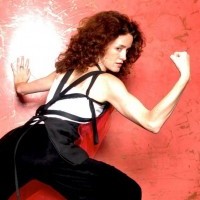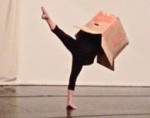
Photo: Carlos Avendano
Human Movement
by Carolyn Merritt
Our story began with migration. On two feet, we sought food in warmer climates, our brains grew, neuron connections multiplied, hemisphere specialization and language ensued. Our movement out of Africa precipitated our rise alongside the decline of other early hominids. We are here for many reasons, not least of which is our ancestors’ spread from one corner of the earth to another. Today, movement signals freedom, autonomy, quality of life, livelihood. The ability to traverse borders, to leave one place and enter another, is arguably the most fraught political issue of our time.
In her most recent dance theater work, Supper, People on the Move, Argentine American choreographer Silvana Cardell showcases how dance can confront social issues viscerally, triggering responses that tap something as deep as migration is to our very existence. She does so by expertly weaving together theatrically overwhelming elements—big props and constantly evolving sets, harsh lights, propulsively violent movement, terrifying scenes that are all too lifelike—with quiet moments that play out like slow-motion tableaus, their fragile exteriors inviting us into the dancers’ and the works’ interiors.
Like our evolution to the present, Supper unfolds as a journey. Large portraits of immigrants alongside excerpts of their personal stories cover the Crane Arts lobby, part of artist Jennifer Baker’s companion piece to the dance work based on interviews with over 50 people now residing in Philadelphia. It feels like an art exhibit—chatter fills the space, the crowd mills about, schmoozing and viewing are on par—until performer Maria Urrutia, looking very much like airport security, appears and barks orders: you will enter the performance soon, form a single file line, have tickets and identification in hand. Red tape marks our path along the floor. The wall-size door slams shut after each group of seven audience members is herded in, only to encounter more bureaucracy on the other side, where we hand over our ‘papers’ and are either admitted into the space or waylaid at another checkpoint, subject to further interrogation.
Inside, audience seats line two sides of the space and a long table set for a meal cuts horizontally through the middle. Smoke wafts through the air. Enormous searchlights occupy each corner, poised to catch the slightest false move. Composer Nick Zammuto’s soundscape ticks like a metronome, louder and faster. William Robinson weaves around the table with a soccer ball, dribbling, heading, juggling; short and boyish, he could be a kid from anywhere, maybe dreaming of life in another place. The ticking heightens to pounding. Merián Soto advances slowly to the table, serene as a statue, fills each glass with water. The others follow, casually greet and embrace. Seated together, they grasp hands and forearms, form diagonal links across the table, arc arms like rainbows and peer underneath. They peel away one by one, the absence in each chair made present with a touch or a glance from a dancer who remains. An ambiguous figure throughout—host, mother, beacon, patria, new world—Soto remains. The lights cut. The story shifts.
Music pulses like techno. From atop tables piled in a corner, trash bags fly and the cast leaps, scrambles after them as if their lives were inside. A bag collapses and papers and fruit spill forth. Bethany Formica clings to the underside of a table like a stowaway. Four dancers ride the unseen waves of a rough sea, conjuring far too many recent stories of migration interrupted. Adrian Plascencia runs the perimeter of the seats, pushing a single sheaf of paper from his palm before each audience member, making sure we know: he belongs here. In silence, he dances a duet with the paper, the only point of contact his hand; in his desperation to keep it aloft, it takes on the weight of gold.
This sense of desperation is nearly ever present, often paired with frantic, brutal movement. The cast are powerhouse performers, though Formica and Robinson have standout moments. In one duet, they trade headstands, toss legs over the other’s shoulders and rise into reverse backbends. Later, Formica lifts her entire body onto and around her single leg lunging onto a table. Robinson flips into one-arm handstands, turns on his head so many times I wonder at its shape underneath his curls.
Their relations evolve along the way, from support to hostility and back again. Urrutia books across the room and dives headfirst into her companions’ arms. A trio of dancers corners Plascencia and rips the clothes from his body. Formica walks through the air on the others’ raised palms, then runs along the wall, her body fully horizontal with their support.
In one of the quieter moments, the music creaks like the hull of a ship and the cast ambles gingerly in a curving path, all weighed down with some sort of baggage. A crutch in hand, Formica hangs from Grieger’s shoulder, falling lower with each step; Robinson balances three stools around his head and shoulders; Plascencia tilts his torso fully sideways, balancing a cup on his cheekbone and its saucer on his thumb. The searchlights brighten and the shadow of a fence looms on the wall. The space closes in and we feel their entrapment, even in movement—the path is interminable, littered with obstacles, perilous.
With few scenic elements, Cardell does much. The searchlights transform the Icebox alternately into a prison yard, a border crossing, a rescue scene, while also directing our focus as the action appears in different corners of the immense space. The tables serve their traditional purpose, only to become flotation devices, barricades, and border fences. The dancers scale them, pull themselves up and peer over, reach through the gaps to the other side, grasping for help, unable to let go. Formica runs the length of the fence, each table collapsing behind her, and we see the ground beneath her feet, life as she knew it, disappearing in that instant. A giant white square, the room—like the stories—could be anywhere. The space engulfs, at times nearly swallowing the dancers whole and at others lengthening their journeys. In still other moments, the room recedes behind powerful imagery, like when Maria Urrutia pours liquid into a teacup, arching back as the cup overflows and the liquid spreads from her feet, her back nearly broken as the last drops descend.
Together, the physical, unrelenting encounter between dancers and audience effects an empathy and a recognition that statistics, reporting, and images so rarely achieve. It is too easy to change the channel, turn the page, allow the horrific details to wash over us and drift away. In the theater, we put away our phones, sit alongside strangers, submit to the event. If, as anthropologist Julie Taylor argues, aesthetic forms can transcend the “particularities” of death, violence, or terror, to convey their dimensions,
[1] then perhaps dance—the earliest of the arts, grounded in the body’s movement—is especially well suited to deepening our understanding of the dimensions of human migration.
So much of the work centers on the disorientation, dehumanization, and trauma of being rootless, homeless. If
Cardell’s own story and those gathered by Baker convey a more multi-faceted portrait of immigration, the theme of liminality—being in between, neither here nor there—links them all. Soto beguiles in transcending this: she takes her time, walks with a regal assurance, ushers the others along. Negating the model of assimilation, she loses nothing as she passes between. In her we see the possibility of incorporating worlds. Perhaps this is the hope of
Supper.
True to its name,
Supper concludes with communal meals around several tables, in which audience and performers share packets of food distributed during the performance. Plascencia sits at our table, explains that the packages are like those prepared by Central American women, tossed to the half million migrants traveling north atop trains each year. I am reminded of watching the documentary
De Nadie/Border Crossing with students, our silence and tears after. I remember the ease with which I entered and left countries in Latin America with no visa to speak of, only my U.S. passport and its unspoken meaning. I reflect on the simple truth that migration for me has always been voluntary—in the form of travel, study, work—that I have always been welcome, for reasons that are undeniably arbitrary. I think back on countless meals shared before, during, and after journeys, how these moments fused past and future, home and the world.
I wonder if any place really belongs to anyone, if anyone belongs to any place, how we might evolve were our movements truly free, if citizenry were a concept applied to earth not country.
Supper, People on the Move, Cardell Dance Theater, Icebox Project Space at Crane Arts, June 25-28.
[1] Taylor, Julie. 1998.
Paper Tangos. Durham, NC: Duke University Press.
By Carolyn Merritt
July 14, 2015









